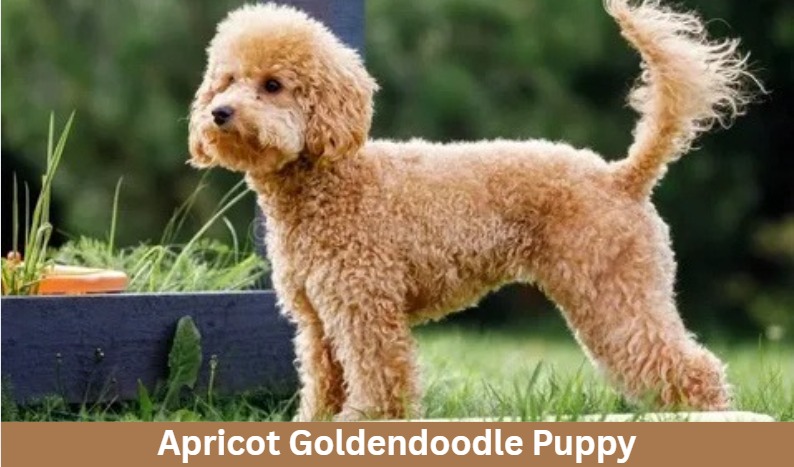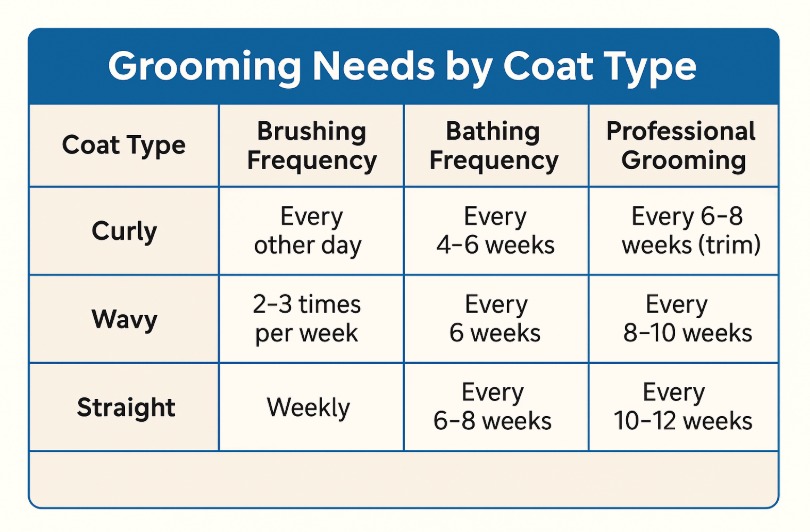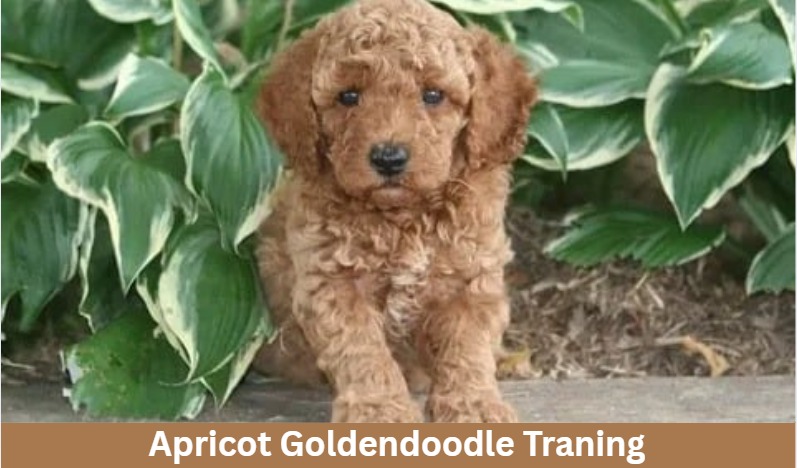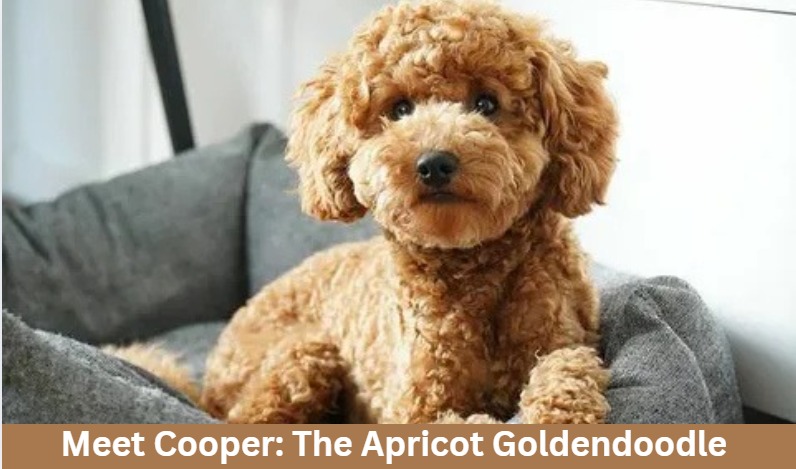
Introduction: Why Choose an Apricot Goldendoodle?
Looking for a furry friend who’s equal parts smart, sweet, and stunning? Meet the apricot Goldendoodle—a golden-haired bundle of joy! These adorable pups are a mix of Golden Retrievers and Poodles, giving them the best traits of both breeds. With their soft, peach-colored coats (ranging from light apricot to rich red-apricot) and curly or wavy fur, they look like living teddy bears.
But it’s not just their looks that win hearts! Apricot Goldendoodles are super friendly, great with kids, and hypoallergenic (perfect for allergy sufferers). They love to play, cuddle, and learn new tricks—making them ideal for families, singles, or seniors.
In this article, you’ll discover:
✔ What makes their apricot coat so special.
✔ Their playful, loving personality.
✔ Easy grooming and care tips.
✔ How to find a healthy, happy pup.
Ready to fall in love? Let’s dive in! 🐾
Apricot Goldendoodle: Quick Facts & Key Takeaways
| Category | Key Points |
|---|---|
| Appearance | Peach-to-amber coats; curly/wavy/straight textures; dark eyes/noses. Puppies lighten/darken with age. |
| Coat Types | Curly: Most hypoallergenic, high-maintenance. Wavy: Balanced. Straight: Rare, sheds more. |
| Size | Mini: 15–35 lbs. Standard: 45–90 lbs. Minis live longer (12–15 years). |
| Temperament | Friendly, great with kids/pets, highly trainable, energetic but adaptable. |
| Health | Prone to hip dysplasia, ear infections, allergies. Screen parents via OFA/PennHIP. |
| Grooming | Brush 2–3x/week (daily for curls). Bathe monthly. Professional trims every 6–8 weeks. |
| Hypoallergenic? | Curly coats shed least (best for allergies). No dog is 100% hypoallergenic. |
| Price | $2,000–$6,000+. Minis/rare red-apricots cost more. Avoid sub-$1,500 breeders. |
| Best For | Families, allergy sufferers, active owners willing to groom regularly. |
What Is an Apricot Goldendoodle?
Where Does the Apricot Color Come From?
The apricot color comes mostly from the Poodle side of the family. Poodles carry a special gene that creates these warm, golden hues. When mixed with a Golden Retriever’s classic gold coat, the result is a stunning apricot shade—sometimes light like a ripe peach, other times richer like autumn leaves.
How Is It Different from Other Goldendoodle Colors?
- Lighter than red Goldendoodles (more peachy than rusty).
- Warmer than cream Goldendoodles (less white, more golden).
- Rarer than classic gold—making apricot pups extra special!
Whether curly or wavy, these sunshine-colored Doodles are as sweet as they look! 🌟
Read more: Why Color Matters in Goldendoodles
The Origin and History of the Apricot Goldendoodle
Let me tell you a fascinating story about how these peachy-coated pups came to be. Back in the 1990s, breeders had a brilliant idea – what if we combined the friendly, outgoing nature of Golden Retrievers with the intelligence and low-shedding coat of Poodles? That’s how the first Goldendoodles were born.
At first, most Goldendoodles had the classic golden retriever coloring. But then something interesting happened. Breeders started noticing that when they used Poodles with that beautiful apricot coloring in their breeding programs, some puppies came out with this amazing peachy-gold coat. It was like nature’s perfect blend of both parents’ best traits!
The Science Behind That Gorgeous Coat
Now, here’s where it gets really cool. That apricot color comes from special genes that Poodles carry. Think of it like mixing paint – the Poodle contributes the apricot “pigment,” while the Golden Retriever adds a golden “tint.” Depending on which genes are strongest, you can get anything from a light, creamy apricot to a deep, rich red-apricot shade.
What’s really neat is that even two apricot Goldendoodles can produce puppies with slightly different shades. It’s like each one gets their own unique version of that warm, sunny color. That’s why no two apricot Goldendoodles look exactly alike!
These special coats didn’t just happen by accident. Thoughtful breeding over many years helped establish and refine that perfect apricot shade we love today. And let me tell you, when you see one of these peachy pups in person, you’ll understand why they’ve become so popular!
The apricot Goldendoodle isn’t just another pretty face though. That beautiful coat comes wrapped around one of the sweetest, most loving personalities you’ll ever find in a dog. But that’s a story for another section.
Meet the Apricot Goldendoodle: A Sunshine-Coated Teddy Bear

You know that warm, golden glow just before sunset? That’s exactly what an apricot Goldendoodle looks like! These dogs are like living teddy bears with coats that range from soft peach to rich amber. Let’s break down what makes them so special:
Coat & Colors: Fluffy and Sun-Kissed
- Coat Texture: Their fur can be curly (like a Poodle’s tight coils), wavy (loose beachy waves), or even shaggy (think “just-rolled-out-of-bed” cute).
- Shades of Apricot: Puppies often start lighter (almost cream) and darken slightly as they grow. Some keep that light peachy hue, while others deepen into a warm, reddish-apricot.
- Eyes & Nose: Most have dark brown eyes that sparkle with mischief, and their noses usually match—either black or a deep brown.
How They Change With Age
- Puppy Stage (0-1 year): Fluffy and light, like a baby chick’s feathers.
- Teen Stage (1-2 years): Coat thickens, and color settles into its final shade.
- Adult Stage (2+ years): Full, glorious fluff! Some may lighten slightly with age (like a sun-bleached surfer’s hair).
Apricot vs. Other Colors: Spot the Difference!
| Color Variant | Description | Visual Comparison | Key Difference from Apricot |
|---|---|---|---|
| Apricot Goldendoodle | Warm peach to amber tones | Summer peach | (Base comparison) |
| Red Goldendoodle | Deep, rusty red tones | Autumn leaves | Richer, darker than apricot |
| Cream Goldendoodle | Very light, almost white | Whipped cream | Lacks golden warmth |
| Tan Goldendoodle | Brown undertones with golden hints | Latte coffee | More brown, less orange |
Fun Fact: Their nose color can hint at their shade—black noses often mean a richer apricot, while brown noses pair with lighter coats.
Whether curly or wavy, puppy or adult, one thing’s certain: that apricot coat is like wearing sunshine! ☀️🐕
Types of Apricot Goldendoodle Coats: Curly, Wavy, and Straight
Apricot Goldendoodles come in three main coat types, each with its own charm and care needs. Whether you love tight curls, loose waves, or a sleek straight look, there’s an apricot Doodle for everyone! “While no dog is 100% hypoallergenic, ASTMA notes Poodle mixes produce fewer allergens.”
1. Curly Apricot Goldendoodles (The Classic Teddy Bear Look)
- Appearance: Tight, springy curls (like a plush toy!)
- Texture: Soft but dense, similar to a Poodle’s coat
- Uniqueness: The curliest coats are most hypoallergenic and shed the least.
- Maintenance:
- Brush every other day to prevent mats.
- Professional grooming every 6-8 weeks for trimming.
- Use a slicker brush and detangling spray.
2. Wavy Apricot Goldendoodles (The “Beachy Hair” Look)
- Appearance: Gentle, loose waves (think surfer-dog vibes)
- Texture: Softer and less dense than curly coats
- Uniqueness: Balances low shedding with easier grooming.
- Maintenance:
- Brush 2-3 times a week.
- Trim every 8-10 weeks.
- Great for owners who want a natural, fluffy look.
3. Straight Apricot Goldendoodles (The Golden Retriever Look)
- Appearance: Sleek, smooth fur (more like a Golden Retriever)
- Texture: Silky but can shed more than curly/wavy types
- Uniqueness: Rare in apricot Doodles—best for fans of the classic Golden look.
- Maintenance:
- Brush weekly to manage shedding.
- Bathe monthly to keep their coat shiny.
Grooming Tips for All Coat Types
✔ Shedding: Curly coats shed the least, straight coats the most.
✔ Tangling: Curly/wavy coats need daily checks behind ears and legs.
✔ Bathing: Every 4-6 weeks with a mild dog shampoo.
✔ DIY Care: Keep a grooming kit with a slicker brush, comb, and dog-safe conditioner.
Pro Tip: If you love the teddy bear look, a curly apricot Goldendoodle is your best bet—just be ready for regular brushing! 🧸🐾
Are Apricot Goldendoodles Hypoallergenic?
If you or someone in your family has allergies but dreams of a fluffy, peachy-coated companion, you’ve probably wondered: Are apricot Goldendoodles really hypoallergenic? The short answer is “Yes, but…”—let’s break it down!
Why They’re Considered Hypoallergenic
Apricot Goldendoodles inherit low-shedding traits from their Poodle side. Their curly or wavy coats trap dander (the real allergy trigger) better than straight-haired dogs. Here’s how coat types rank:
- Curly coats (most hypoallergenic): Shed least, trap dander best.
- Wavy coats (moderate): Shed lightly but need regular grooming.
- Straight coats (least hypoallergenic): Shed more like Golden Retrievers.
Myths vs. Facts
❌ Myth: All Goldendoodles are 100% hypoallergenic.
✅ Fact: No dog is completely hypoallergenic, but apricot Doodles with tight curls are the safest bet for allergy sufferers.
❌ Myth: Coat color (apricot, red, etc.) affects allergies.
✅ Fact: It’s the coat type (curly/wavy/straight)—not the color—that matters!
❌ Myth: Bathing them daily reduces allergies.
✅ Fact: Over-bathing dries their skin, increasing dander! Stick to monthly baths with hypoallergenic shampoo.
Tips for Allergy-Prone Owners
✔ Test Before Adopting: Spend time with an apricot Doodle to check reactions.
✔ Grooming Routine: Brush 2-3x weekly and vacuum often to catch loose hair/dander.
✔ Air Purifiers: Use HEPA filters to reduce airborne allergens.
Bottom Line: An apricot Goldendoodle with a curly coat is your best shot at an allergy-friendly pup—but always consult your allergist first! 🤧🐕
Read more about: Are all Goldendoodles hypoallergenic?
Size and Growth: What to Expect from an Apricot Goldendoodle
Whether you’re dreaming of a teacup-sized cuddler or a bigger, playful companion, apricot Goldendoodles come in different sizes—each with its own quirks and care needs. Let’s break it down so you know exactly what to expect!
Size Categories: From Mini to Standard
| Type | Height (Full-Grown) | Weight (Full-Grown) | Best For |
|---|---|---|---|
| Mini Apricot Goldendoodle | 13–20 inches | 15–35 lbs | Apartments, small families, easy travel |
| Medium (Not Always Officially Recognized) | 17–21 inches | 30–45 lbs | Active families, first-time dog owners |
| Standard Apricot Goldendoodle | 20–26 inches | 45–90 lbs | Big homes, active lifestyles, therapy work |
Mini Apricot Goldendoodles: Pocket-Sized Sunshine
- Growth Rate: Reach full size by 10–12 months.
- Behavior: Often feistier and more energetic (big personality in a small body!).
- Care Needs:
- Less space required, but still need daily exercise.
- Prone to toy obsession—supervise playtime!
Read more about: Mini Goldendoodle puppy
Standard Apricot Goldendoodles: Gentle Giants
- Growth Rate: Fill out by 12–18 months (but may act like puppies for years!).
- Behavior: Typically calmer and more patient (great with kids).
- Care Needs:
- Require more food, bigger beds, and stronger leashes.
- Better suited for homes with yards.
Read more about: Standard Goldendoodle puppy
Apricot Mini Goldendoodles: Special Considerations
- Health Watch: Minis can be prone to luxating patellas (knee issues)—avoid over-jumping.
- Training Tip: Their small size doesn’t mean less training! They’re smart but stubborn.
- Grooming: Same coat types (curly/wavy), but tiny bodies = faster grooming sessions.
Fun Fact: A mini apricot Doodle’s lifespan (12–15 years) is often longer than a standard’s (10–12 years) due to size genetics!
Read more in detail about: Micro mini Goldendoodle
Growth Chart (Puppy to Adult)

Notes on Growth:
- Mini Doodles stop growing earlier (10–12 months), while Standards may fill out until 18 months.
- Weight ranges vary based on genetics (e.g., a mini with a larger Poodle parent might hit 20 lbs by 6 months).
- For accuracy, ask your breeder for the parents’ weights.
Pro Tip: If you’re set on a mini apricot Goldendoodle, ask breeders about the parents’ sizes—some “minis” end up bigger than expected!
Grooming and Maintenance of an Apricot Goldendoodle
Apricot Goldendoodles are famous for their soft, peachy coats, but keeping them looking their best requires regular care—especially for curly apricot Goldendoodles, whose tight curls can easily tangle. Here’s everything you need to know to keep your pup’s coat fluffy, mat-free, and shiny! The American Kennel Club (AKC) advises weekly brushing for curly coats to prevent matting.
1. Grooming Needs by Coat Type

Special Care for Curly Apricot Goldendoodles
- Mats love to hide behind ears, under legs, and around the collar.
- Use a slicker brush first, then follow with a wide-tooth comb to check for tangles.
- Spritz with detangling spray before brushing to avoid pulling hair.
2. Must-Have Grooming Tools
✔ Slicker brush (for daily detangling)
✔ Metal comb (to check for hidden mats)
✔ Dog-safe detangling spray (keeps curls soft)
✔ Blunt-tip scissors (for trimming small knots)
✔ Hypoallergenic shampoo (preserves coat color)
Pro Tip: For curly coats, try the “line brushing” method—brush layer by layer down to the skin to prevent mats.
3. Bathing & Coat Care Routine
- Brush before baths (wet tangles turn into mats!).
- Use lukewarm water and a moisturizing dog shampoo (avoid human products—they dry out their skin!).
- Conditioner is a must for curly coats to maintain softness.
- Dry thoroughly with a blow dryer on low heat (high heat can damage curls).
For Extra Shine:
- Add a teaspoon of salmon oil to their food for a healthy coat.
- Wipe their coat with a damp cloth between baths to remove dirt.
4. Preventing & Fixing Mats
- Small mats? Gently work them out with your fingers or a comb.
- Severe mats? Don’t pull—trim carefully with scissors or visit a groomer.
- Avoid shaving unless necessary (their coat protects their skin!).
Myth Buster:
❌ “Shaving keeps them cooler in summer.”
✅ Truth: Their curls actually insulate against heat—just keep them brushed!
5. Seasonal Care Tips
- Summer: Check for hot spots (red, irritated skin) after swimming.
- Winter: Use paw balm to protect from salt and ice.
- Spring/Fall: Brush more often—they’ll shed slightly during seasonal changes.
Final Thought
A well-groomed apricot Goldendoodle isn’t just pretty—it’s healthier and happier! With regular brushing and the right tools, even a curly apricot Goldendoodle can stay tangle-free and cuddle-ready.
Health Considerations for Apricot Goldendoodles
Apricot Goldendoodles are generally healthy dogs, but like all breeds, they can be prone to certain health issues. Their Golden Retriever and Poodle genes influence their risks, and their coat color doesn’t directly affect health—but being informed helps you keep your pup happy and thriving!
Common Health Risks in Apricot Goldendoodles
| Condition | Symptoms | Prevention/Treatment |
|---|---|---|
| Hip Dysplasia | Limping, stiffness, difficulty standing | Weight management, joint supplements, vet X-rays |
| Ear Infections | Head shaking, odor, redness | Weekly ear cleaning (use vet-approved solution) |
| Allergies | Itchy skin, paw licking, ear infections | Hypoallergenic diet, omega-3 supplements |
| Eye Issues (Progressive Retinal Atrophy, Cataracts) | Cloudy eyes, night blindness | Annual vet eye exams, antioxidant-rich diet |
| Addison’s Disease (Poodle-linked) | Lethargy, vomiting, weight loss | Blood tests, lifelong medication |
Note: Minis may also face luxating patellas (knee slipping)—avoid stairs for puppies.
Apricot Goldendoodles may inherit hip dysplasia, a condition the Orthopedic Foundation for Animals (OFA) recommends screening for in parent breeds.
Proactive Health Tips
Diet & Weight Management
- Feed high-quality kibble (look for glucosamine for joints).
- Avoid overfeeding—Goldendoodles gain weight easily!
- Healthy snacks: Carrots, blueberries, pumpkin (no grapes/onions!).
Exercise & Joint Care
- Daily walks + playtime, but avoid jumping on/off furniture (hard on hips).
- Swimming is perfect for low-impact exercise.
Regular Vet Checkups
- Annual bloodwork (catches early signs of Addison’s).
- Dental cleanings (prevent gum disease—common in Doodles).
Genetic Testing & Responsible Breeding
- Ask breeders for:
- Hip/elbow scores (OFA/PennHIP certifications).
- Eye test results (CERF/OFA).
- Genetic screening (for PRA, von Willebrand’s disease).
- Red flag: Breeders who dismiss health testing.
Signs Your Apricot Goldendoodle Needs a Vet
🚨 Sudden lethargy or loss of appetite
🚨 Excessive scratching/red skin (allergies or mites)
🚨 Cloudy eyes or bumping into walls (possible PRA)
Lifespan & Quality of Life
- Average lifespan: 10–15 years (minis often live longer).
- Boost longevity with:
- Mental stimulation (puzzle toys, training).
- Routine grooming (prevents skin infections).
- Love! Stress-free homes = healthier dogs.
Read more about: Are Goldendoodles healthiest dog breed?
Training an Apricot Goldendoodle: Tips for Success

Apricot Goldendoodles—whether mini or standard—are smart, eager-to-please pups thanks to their Poodle and Golden Retriever genes. But their intelligence means they need consistent training and socialization to thrive. Here’s how to raise a well-behaved, happy Doodle!
1. Start Early: Puppy Training Basics
Best Age to Begin: 8–12 weeks old
Key Focus Areas:
✔ Potty Training
- Use a routine (after meals, naps, playtime).
- Reward with treats/praise for outdoor success.
✔ Crate Training
- Make the crate cozy (soft blankets, toys).
- Never use it for punishment.
✔ Basic Commands
- Teach “sit,” “stay,” “come” first (use high-value treats like chicken).
- Keep sessions short (5–10 mins) and fun!
Pro Tip: Mini apricot Goldendoodles can be stubborn—use patience and consistency!
2. Socialization: Prevent Shyness or Aggression
What to Expose Them To (Before 6 Months Old):
- People: Kids, hats, sunglasses, men with beards.
- Animals: Friendly dogs, cats, squirrels (on leash!).
- Environments: Parks, car rides, vet visits.
How to Socialize Safely:
- Puppy classes = great for confidence.
- Avoid dog parks until vaccines are complete.
3. Behavior Training: Fix Common Issues
| Problem | Solution |
|---|---|
| Jumping | Ignore until calm, then reward “sit.” |
| Barking | Teach “quiet” with treats for silence. |
| Leash Pulling | Stop walking when they pull; resume when loose. |
| Separation Anxiety | Practice short departures; leave puzzle toys. |
For Curious Chewers:
- Redirect to approved toys (Kong, bully sticks).
- Spray bitter apple spray on furniture legs.
4. Exercise Needs: Burn Energy the Right Way
Daily Requirements:
- Mini Apricot Doodles: 30–45 mins (walks + play).
- Standard Apricot Doodles: 60+ mins (fetch, swimming, hikes).
Mental Stimulation Ideas:
- Puzzle toys (hide treats inside).
- Obedience drills (teach “roll over,” “shake”).
- Nose work (hide treats around the house).
Warning: Underexercised Doodles become destructive (chewing, digging)!
5. Advanced Training (For Older Puppies/Adults)
- Off-leash training (practice in fenced areas first).
- Therapy dog certification (great for calm Doodles).
- Trick training (“spin,” “play dead”).
6. Golden Rules for Success
✨ Positive reinforcement ONLY (no yelling—they shut down!).
✨ Be patient—some minis take longer to housebreak.
✨ Train before meals (food motivation helps!).
Fun Fact: Apricot Goldendoodles often excel in agility courses thanks to their athleticism!
Read more about: Goldendoodles are smartest dog breeds?
Are Apricot Goldendoodles Good Family Pets?
Apricot Goldendoodles are exceptional family pets thanks to their friendly, patient temperament and love for companionship. These sunny-natured dogs adore children, matching their playful energy while being gentle enough for toddlers (though supervision with very young kids is always wise). They typically get along wonderfully with other pets, including cats, especially if socialized early. Their intelligence and eagerness to please make them easy to train for family life, while their low-shedding coats are a bonus for busy households. Whether it’s cuddling on the couch or joining backyard games, an apricot Goldendoodle thrives when included as a cherished member of the family. Read our in-depth detail on Are Goldendoodles good family pets
The Popularity of Apricot Goldendoodles
Apricot Goldendoodles have stolen hearts worldwide, and it’s easy to see why! Their warm, peachy coats—ranging from soft pastel to deep amber—give them a sun-kissed glow that stands out in the Goldendoodle community. Unlike common cream or gold Doodles, the apricot shade feels uniquely luxurious, evoking the charm of a sunset or a ripe peach. This rarity drives demand, with many families willing to wait months (or pay a premium) for one.
How Apricot Compares to Other Colors
- Vs. Red Goldendoodles: Apricots are softer and lighter (think peach vs. rust).
- Vs. Cream: Apricots have warmer golden undertones, while creams lean icy/white.
- Vs. Tan: Tans mix brown with gold, while apricots stay purely peachy.
- Vs. Parti (two-tone): Apricots are solid-colored, offering a classic, elegant look.
Why the Hype? Beyond beauty, apricot Doodles photograph stunningly, making them Instagram darlings. Breeders note their coats often age gracefully, maintaining warmth even as puppies darken slightly. Whether it’s their rarity, aesthetic appeal, or that “teddy bear” charm, apricot Goldendoodles remain a top-tier favorite—proof that sometimes, the sweetest things come in peachy packages! 🍑✨
A Real Owner’s Story: Meet Cooper, the Apricot Goldendoodle Who Stole Our Hearts

When we first brought Cooper home as a wiggly, 10-week-old apricot Goldendoodle, we had no idea how much sunshine he’d bring into our lives. His coat was the color of a ripe peach—lighter than the “red Goldendoodle” we’d seen at the breeder’s, but with that signature teddy bear curl we couldn’t resist.
The Puppy Days
Cooper’s hypoallergenic coat was a lifesaver for my husband’s allergies, but those curls? They demanded work. I quickly learned the “line brushing” method to prevent mats (his favorite hiding spot: behind his ears!). By 6 months, his color deepened to a warm amber—just like the breeder predicted.
Family Life
Our kids (ages 5 and 8) adored him, though Cooper’s idea of “helping” with homework involved stealing pencils. His gentle temperament shone when our grumpy cat, Mochi, finally tolerated his presence after a year of strategic treat bribes.
The Happy Accident
We’d planned for a mini Goldendoodle, but Cooper topped out at 42 lbs—proof that even with genetic testing, Doodles keep you guessing! His energy matched his size: daily fetch sessions, obsession with the sprinkler, and an uncanny ability to detect cheese from three rooms away.
Now at 3 Years Old
Cooper’s coat has lightened slightly (think “sun-bleached apricot”), and he’s traded puppy zoomies for couch cuddles. But he still turns heads on walks—stranders always ask, “Is he as soft as he looks?” (Spoiler: Yes.)
Our Advice to New Owners
- Embrace the grooming. Those curly apricot Goldendoodle coats are high-maintenance but worth it.
- Socialize early. Cooper’s best friend is a Great Dane he met in puppy class!
- Love the surprises. The “micro mini Goldendoodle full grown” you envision might not happen… and that’s okay.
Cooper taught us that apricot Goldendoodles aren’t just pets—they’re family comedians, therapists, and adventure buddies rolled into one fluffy package. Would we do it again? In a heartbeat.
Price and Adoption: How Much Does an Apricot Goldendoodle Cost?
Apricot Goldendoodles are among the most sought-after color variations, often commanding higher prices than standard gold or cream Doodles. Here’s what to expect when budgeting for your peachy pup:
Price Breakdown
| Type | Price Range | Key Factors |
|---|---|---|
| Mini Apricot Goldendoodle | $2,500–$5,000+ | Rarity, smaller size = higher demand |
| Standard Apricot Goldendoodle | $2,000–$4,500 | More common, but still premium for color |
| Rare Red-Apricot | $3,000–$6,000+ | Deep, rich hue = top-tier pricing |
What Drives the Cost?
✔ Breeder Reputation (health testing, titles, or champion bloodlines add $1,000+).
✔ Coat Type (curly apricot Doodles often cost more than wavy/straight).
✔ Location (urban areas = higher prices).
✔ Generation (F1B apricot Goldendoodles—75% Poodle—are pricier for hypoallergenic traits).
Adoption Option
- Rescues: $300–$800 (rare, but check Goldendoodle-specific rescues).
- Rehoming Fees: $1,000–$2,500 (often includes vet records).
Red Flags:
🚩 Under $1,500 (likely backyard breeder, no health testing).
🚩 No color guarantees (apricot puppies may fade to cream).
Reputable breeders often register with the Goldendoodle Association of North America (GANA).
If you’re considering a tiny companion, you might be torn between a teacup mini Goldendoodle and a micro mini Goldendoodle. While these ultra-small Doodles are adorable, it’s important to understand their needs—a micro mini Goldendoodle full grown typically weighs under 15 pounds, making them fragile for rough play. For those concerned about shedding, you’ll be glad to know do F1BB Goldendoodles shed less than most breeds, thanks to their high Poodle genetics (75% or more). But remember, even a micro Goldendoodle requires regular grooming to prevent mats in their tight curls. Always research breeders carefully, as super-small sizes can come with health risks.
Conclusion: Is an Apricot Goldendoodle Right for You?
If you’re dreaming of a smart, affectionate dog with a show-stopping coat, the apricot Goldendoodle might be your perfect match. These pups combine the best traits of Poodles and Golden Retrievers—hypoallergenic curls, a playful yet gentle temperament, and that irresistible peachy-gold glow. They’re ideal for:
✔ Families (patient with kids, great with other pets).
✔ Allergy sufferers (low-shedding coats).
✔ First-time owners (eager to please, easy to train).
✔ Active households (loves walks, hikes, or couch cuddles!).
But remember: Their grooming needs (brushing, trims) and price tag (rarity = premium cost) require commitment. If you’re ready for a loyal, sunny-natured companion who turns heads at the dog park, an apricot Goldendoodle could be your happily-ever-after pup.
Still unsure? Reach out with questions—we’re happy to help you decide! 🐶💛
Frequently Asked Questions (FAQs)
What is an apricot Goldendoodle?
An apricot Goldendoodle is a Poodle-Golden Retriever mix with a soft, peachy-gold coat. This coat color gives them a warm, teddy bear look. They’re known for their friendly and playful personality.
How much do apricot Goldendoodles shed?
Apricot Goldendoodles are low-shedding dogs, especially those with curly coats. Wavy or straight coats may shed a bit more, but still much less than many other breeds. Regular brushing helps keep shedding under control.
Are apricot Goldendoodles good with children?
Yes, apricot Goldendoodles are very gentle and loving with kids. They enjoy playtime and make excellent companions for children. Their sweet nature makes them perfect for families.
How long do apricot Goldendoodles live?
Most apricot Goldendoodles live between 10 to 15 years. Mini Goldendoodles often live a little longer than standards. A healthy lifestyle and regular vet checkups can extend their life.
What are the grooming needs of an apricot Goldendoodle?
They need regular brushing based on coat type—curly coats need it more often. Baths every 4–8 weeks help maintain a clean, soft coat. Professional grooming is also needed every 6–12 weeks.
Do apricot Goldendoodles have any specific health concerns?
They may face common doodle issues like joint or eye problems, but their coat color doesn’t cause extra risk. Responsible breeding helps reduce health concerns. Always check for health-tested parents.
How much exercise does an apricot Goldendoodle need?
They need at least 30–60 minutes of daily exercise to stay happy and healthy. Walks, fetch, and games are great ways to meet their needs. Minis may need slightly less but still love activity.
Can apricot Goldendoodles be trained easily?
Yes, they are very intelligent and eager to learn. They respond best to positive, reward-based training. Early socialization and consistency make training even smoother.
Are apricot Goldendoodles good for people with allergies?
They are a great option for allergy sufferers thanks to their low-shedding coats. Curly coats are usually more hypoallergenic than wavy or straight ones. No dog is fully allergy-free, but they come close.
What size variations are available for apricot Goldendoodles?
Apricot Goldendoodles come in mini, medium, and standard sizes. Minis weigh 15–35 lbs, while standards can grow up to 90 lbs. The size depends on the Poodle parent’s size.
How do I find a reputable apricot Goldendoodle breeder?
Choose a breeder who does health testing and gives a clear health guarantee. Visit the location, ask questions, and meet the puppy’s parents. Avoid breeders who can’t show proper records or push for quick sales.
Are apricot Goldendoodles rare?
Apricot is one of the most common and loved Goldendoodle colors. It’s not considered rare, but deeper or richer shades may be harder to find. Many people love this color for its teddy bear appearance.
What is the price difference between apricot and other Goldendoodle colors?
Apricot Goldendoodles may cost a bit more because of their popularity. Price also depends on size, coat type, and breeder quality. Expect anywhere from $1,500 to $3,000 on average.
How to care for a curly apricot Goldendoodle?
Brush their coat every other day to avoid tangles and mats. Use gentle dog shampoo and see a groomer every 6–8 weeks. Keep their ears clean and nails trimmed for full care.





Comments (1)
tlover tonetsays:
October 8, 2025 at 10:16 amI have read several good stuff here. Definitely worth bookmarking for revisiting. I surprise how much effort you put to make such a wonderful informative website.